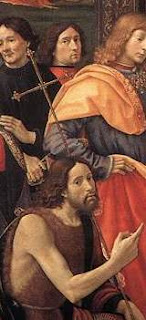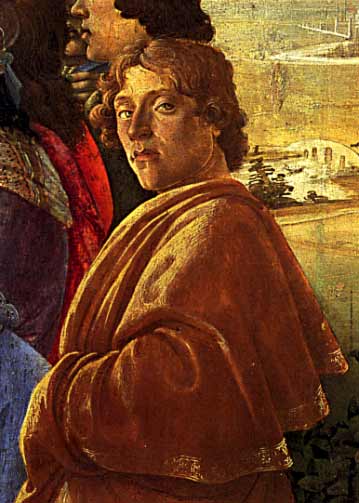Sunday, January 9th, 2011
Istoria Paintings: Here’s Looking at You, Kid
I’m getting ready to teach a lecture on Alberti’s theories regarding the type of painting called istoria (also seen as historia). In his treatise On Painting (1435), Alberti argued that istoria painting is the highest goal and achievement for an artist. An istoria is a narrative painting which includes a complex composition and a large number of figures. Furthermore, these figures should be displayed in several dramatic and emotive poses. Alberti felt that “everything the people in the painting do among themselves, or perform in relation to the spectators, must fit together to represent and explain the ‘historia.'”1
One of Alberti’s most interesting ideas about istoria has to do with how the painting communicates and involves the viewer. Alberti found that an istoria painting is most effective if there is a figure in the painting who directly communicates with the viewer. He wrote, “I like there be someone in the ‘historia’ who tells the spectators what is going on, and either beckons them with his hand to look, or with ferocious expression and forbidding glance challenges them not to come near, as if he wished their business to be secret, or points to some danger or some remarkable secret, or by his gestures invites you to laugh or to weep with them.”2
I think one of the best ways for istoria figures to communicate with the viewer is through an outward glance (as if the figure was actually looking at the viewer).3 I know that there are tons of examples of such outward glances, but here is just a small sample of my favorites:
I think it’s interesting that so many painters decided to include themselves as the token “communicating figure” within their paintings. The examples by Ghirlandaio, Botticelli and Perugino are a small sampling of the staring/communicating self-portraits which exist. (To give you an idea, other such self-portraits were done by are Jacopo Pontormo (see here), Raphael (see here) and Fillipo Lippi (see here and here). But, the more that I think about it, the inclusion of the self-portrait is very fitting for historia painting, particularly when considering Alberti’s thoughts on communication. After all, if at least one figure is responsible for communicating to the viewer (and drawing the viewer into the scene), shouldn’t that figure be the artist?!? Makes sense to me.
What about you? What paintings do you enjoy where a figure is staring outwards at (or beckoning toward) the viewer? I know there are tons of them out there – especially from the Italian Renaissance period!



Super post M! I love the viewer directed glances from within paintings – there is something very personal and touching about it – especially when it is believed to be the artist themselves.
My fave would have to be Benozzo Gozzoli amongst the Procession of the Magi at the Medici Chapel. You can see a pic here
Funnily enough, he writes his name on his hat so you can easily pick him out!
H
I have three favorites. Number 1 is naturally Giorgione's Tempest where the Woman looks out and virtually invites the viewer to enter the picture. On the left, exactly where Alberti would have placed him, is the Man acting as an "interlocutor" directing our attention to the Woman and Child.
Number 2 is Bellini's "St. Francis in the Desert" where the tree on the left acts as an interlocotor and bends toward St. Francis.
Number 3 is Titian's "Pesaro altarpiece" where all the figures are looking in different directions for different reasons. The boy on the right who looks our at the viewer has been identified as the only male heir of the family. If you view this altarpiece on site in the Frari, the eyes of the boy look directly at you no matter where you stand.
Good luck on your lecture.
Frank
Another fun subject. Here are a few favourites (some definitely fall outside of the definition of Historia):
1. Titian's Venus with a Mirror, where Venus seems to look towards us with the help of the mirror.
http://tinyurl.com/28kpfru
2. Rembrandt's Night Watch. A number of candidates, but for me the most memorable one is the fragment of a face / eye seen behind the shoulder of the standard bearer.
http://tinyurl.com/cwwhkb
3. Fragonard's The Swing, where the statue representing "discretion" plays this kind of editorializing function, even though he doesn't look at us.
http://tinyurl.com/34r3dbz
4. Manet's Olympia, where (famously!) her direct gaze turns the viewer into a potential client. And also look at the black cat.
http://tinyurl.com/mmbnul
5. And, for something truly odd, what about those miniatures that are almost all eye. E.g. http://tinyurl.com/2by9j2j
Ben
I love the examples that everyone gave! H Niyazi, I think you're right: there is something very personal about having a figure gaze at the viewer. Alberti said that he wanted to move the viewer with historia paintings, and I think that such a personal connection also can help the viewer feel connected/moved by the work of art.
Dr. F, your example of Bellini's tree was interesting. The tree does help to draw you into the scene – even if it isn't the traditional type of (human) figure that Alberti implied in his treatise! Well spotted!
Obridge, I'm glad that you brought up other examples that go beyond the Renaissance. (And it's also important to recognize that not all of these staring/communicating figures are placed in traditional examples of "historia" paintings – which could be said of Giorgione's "Tempest," since it does not include a complex composition with a large number of figures. Nonetheless, these artists are still following aspects of the historia tradition – perhaps whether they realize it or not!)
And I loved your miniature example, by the way. That's too funny. Your Titian example with the mirror is also really interesting. Boy, one could do a lots of analysis with that painting (e.g. Lacan's mirror, the issue of spectatorship, etc.). What fun stuff. Thanks for sharing.
I love this blog,M. I learn something each time I read a post and usually take away something interesting to ponder and/or process.
As you know, I am not an art historian, but I love art. I usually do not comment, but want you to know how much I learn here.